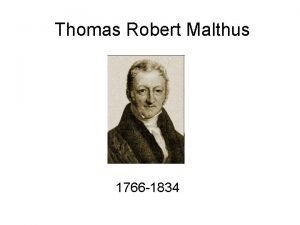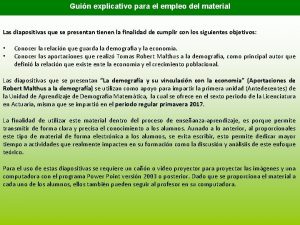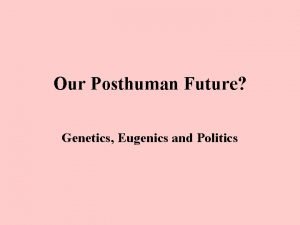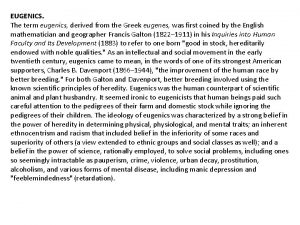THE GENIUS FACTORY ELLEN ANTONIEWICZ EUGENICS Thomas Malthus























- Slides: 23

THE GENIUS FACTORY ELLEN ANTONIEWICZ

EUGENICS • Thomas Malthus outlined the first key ideas of what would become eugenics • The misery of the poor was due to their nature • Their suffering and early death was positive because it prevented them from passing on their innate weakness • Francis Galton created the science of eugenics through his book, Hereditary Genius, written in 1869

EUGENICS CONTINUED • Developed in Britain, practiced in America • Spread to other countries as well, Germany was especially interested in the ideas of Nordic supremacy and eugenics • Shift from negative eugenics to positive eugenics

ROBERT K. GRAHAM: EARLY LIFE • Born June 9, 1906 in Harbor Springs, Michigan • Frank Graham • The local dentist • Chilly and formal • Fern Klark, gracious and gentle • Robert was the oldest of four children • The Graham family lived on East Bluff Drive • Caddy for the two private golf courses in Harbor Springs

EDUCATION AND EARLY CAREER • Graduated from Harbor Springs High School in 1924 • University of Michigan in Ann Arbor and later Michigan State University to study music • Graduated from Ohio State with a degree in optometry in only 18 months Photo from The Genius Factory by David Plotz

EARLIER PROJECTS • Worked at Univis as a salesman for optical products • Founded Armorlite in 1947 • Invented shatterproof plastic eyeglasses • Helped perfect contact lenses, developed the first antireflective coating for plastic lenses, and manufactured the first UV-protective lenses • Grahamland

PERSONAL LIFE • He had three wives • Elizabeth • Estelle • Marta Ve Everton • Had a total of 8 children • Was emotionally distant with his children similar to his own father • His three daughters, especially those with Marta were very successful • Did not have a good relationship with his sons, and even avoided introducing them to his friends

GRAHAM’S VIEWS ON GENETICS • His interest in reproduction and genetics began in his childhood after the death of his idol, Ephraim Shay, the inventor of the Shay locomotive • The Future of Man (1970) • Mankind peaked 15, 000 years ago prior to the Agricultural Revolution • Contained the idea for repositories where women could go to be artificially inseminated with superior sperm and combat the spread of idiocy

GRAHAM’S VIEWS ON GENETICS CONTINUED • Complained that modern American social welfare programs paid incompetents and imbeciles to reproduce • Believed that the lessening of intelligence is what led to the rise in communism • A way to squash brilliance and promote mediocrity

THE HISTORY OF ARTIFICIAL INSEMINATION • The first recorded use of a sperm donor was in 1884 at Sansom Street Hospital by Dr. William Pancoast • Starting in the 1930 s, British doctor Margaret Jackson began providing freshly donated sperm to patients to use for artificial insemination • In the 1950 s, doctors began performing artificial inseminations regularly in larger cities • By 1960, Artificial insemination was responsible for creating 5, 000 to 7, 000 babies a year • Doctors were in charge of finding a donor rather than the parents choosing someone

THE HISTORY OF ARTIFICIAL INSEMINATION CONTINUED • The process for freezing sperm was perfected in the 1950 s and 1960 s • Allowed sperm banking to become a business • The 1987 and 1988 Office of Technology Assessment survey of the sperm bank industry • Hundreds of sperm banks • More than 11, 000 doctors performing inseminations • Estimated that 30, 000 children per year were being born from anonymous donor sperm

THE EARLY STAGES OF THE REPOSITORY • Hermann Muller, a eugenicist, created the idea for repositories that contained sperm from men who were both brilliant and altruistic • Muller wanted to create a socialist, egalitarian society, while Graham intended to create a generation of elite people to combat the lessening of intelligence • Graham was concerned with intelligence only • Graham needed to decide how he would measure the world’s most elite men • Decided that the best measure of intelligence was through useful contributions • Chose to only include Nobel Prize winners in the sciences in his project

THE REPOSITORY FOR GERMINAL CHOICE • The Repository for Germinal Choice launched in 1980 with the goal of changing mankind and reversing evolution • The repository had three Nobel prize winning donors • Sperm samples for the repository were initially stored in an underground bunker on Graham’s estate in Escondido, California • Samples were initially given only to married women who had an IQ high enough to qualify for the Mensa society • All but two of the donors to the project in its 19 years of operation were White • Operational until 1999 • 215 “genius kids” were born from this project Photo from The Genius Factory by David Plo

THE REACTION TO THE NOBEL PRIZE SPERM BANK • Nicknamed the Nobel Prize Sperm Bank • Graham was accused of sexism, racism, elitism, white supremacism, and Nazism • Often compared to Hitler • Geneticists: Intelligence was not entirely DNA-linked • Andrologists: Nobel winners were too old to be effective donors • Statisticians said Graham was trying to fool customers who thought that they were guaranteed to have a genius baby

SCANDAL CONTINUES TO STRIKE THE NOBEL PRIZE SPERM BANK • William Shockley was one of the initial Nobel prize winning donors • The first Nobel prize baby, Victoria Kowalski • Couples continued to apply to the clinic • Applications always exceeded the available sperm samples

CHANGING CRITERIA • By late 1980 the Nobel Prize Sperm Bank had no Nobel Prize Sperm donors and no sperm left in storage • No babies were born from the Nobel prize winning donors’ sperm • The Nobelists had three problems in Graham’s view: • There were too few of them to meet demand • They were too old which raised the risk for genetic abnormalities • They were too eggheaded • Customers wanted more than just brains from the donors, they also commonly asked if the donor was attractive and if he was tall • https: //www. youtube. com/watch? v=6 Y 79 Kpy 4 IYA (4: 35 -6: 10)

THE RENAISSANCE MEN • Michael • Son of a nobelist • Considered sperm donation his job • Had “worked” for approx. 6 doctors and 3 sperm banks • Donor White • A successful scientist • He and his wife were unable to have children • Was over 50 when he started donating • Had over 12 children through the repository Photo from The Genius Factory by David Plotz

THE RENAISSANCE MEN CONTINUED • Donor Coral • Volunteered in 1984 as a medical student • Approx. 30 children were born from Donor Coral’s sperm • Has six ex-wives and over 18 children (not including the ones through the sperm bank) • Not Jonas Salk, inventor of the polio vaccine Photo from The Genius Factory by David Plotz

A GENIUS BABY IS BORN • The second Nobel Prize Sperm Bank baby was Doron Blake, the son of Afton Blake • Doron was born in August of 1982 • At 4 months old he had a mental age of 8 months • In response to a reporter asking him if he read Hamlet in kindergarten, Doran replied “Good gosh. Can’t everybody? ” • Doran was Graham’s success story and he cited him every time that the sperm bank was criticized

THE DECLINE OF THE REPOSITORY FOR GERMINAL CHOICE • The clinic’s organization was terrible and some of their practices questionable • Age Limits • Color codes • Limit on number of children produced • The repository spent about $170, 000 a year to collect and distribute the sperm. It was only bringing in between $20, 000 and $40, 000 from customer fees • Graham died on February 13, 1997 at 91 years old • The bank was then passed to Floyd Kimble who ran it until 1998

ARTIFICIAL INSEMINATION AFTER GRAHAM • Shift toward more informed decisions in choosing a sperm donor • Other sperm banks adopted Graham’s technique of including a short biographical page • Family and medical history • Physical characteristics

WHAT BECAME OF THE NOBEL PRIZE SPERM BANK BABIES? • In 1992, Graham sent out a survey to the parents of the Nobel Prize Sperm Bank babies • Plotz, has found 30 of the Genius Factory children • Range widely in their intellectual success • Small sample would be considered slightly above the norm in either athletic or intellectual pursuits NPR (7: 40) https: //www. npr. org/2014/10/03/353491991/genius-sperm

DISCUSSION QUESTIONS • Do you think that the success of some of the Nobel babies was due more to genes or to the type of parent that the child had? • Do you think that sperm banks should be considered a part of positive eugenics, because of their donor descriptions? • Do you think that believing that they have exceptional genes may cause the Nobel babies to be above average?
 Thomas malthus industrial revolution
Thomas malthus industrial revolution Thomas robert malthus (1766-1834)
Thomas robert malthus (1766-1834) Thomas malthus overpopulation
Thomas malthus overpopulation Thomas robert malthus
Thomas robert malthus David ricardo and thomas malthus
David ricardo and thomas malthus Thomas malthus carrying capacity
Thomas malthus carrying capacity Overpopulation theory
Overpopulation theory The us center of population has moved steadily to the
The us center of population has moved steadily to the The genius factory
The genius factory The impact factory
The impact factory Eugenics
Eugenics Eugenics definition
Eugenics definition Eugenics
Eugenics Anthony thomas candy bar fundraiser
Anthony thomas candy bar fundraiser Malthus rant
Malthus rant Malthus
Malthus Biografia de robert malthus
Biografia de robert malthus Forensic anthropologist vs forensic pathologist
Forensic anthropologist vs forensic pathologist Tư thế ngồi viết
Tư thế ngồi viết Thẻ vin
Thẻ vin Cái miệng bé xinh thế chỉ nói điều hay thôi
Cái miệng bé xinh thế chỉ nói điều hay thôi Các châu lục và đại dương trên thế giới
Các châu lục và đại dương trên thế giới Cách giải mật thư tọa độ
Cách giải mật thư tọa độ Bổ thể
Bổ thể







































